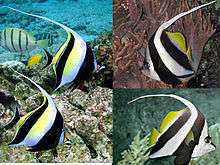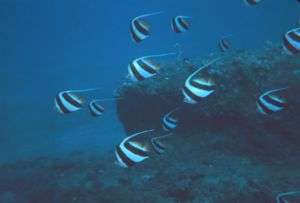Pennant coralfish
| Pennant coralfish | |
|---|---|
 | |
| Scientific classification | |
| Kingdom: | Animalia |
| Phylum: | Chordata |
| Class: | Actinopterygii |
| Order: | Perciformes |
| Family: | Chaetodontidae |
| Genus: | Heniochus |
| Species: | H. acuminatus |
| Binomial name | |
| Heniochus acuminatus (Linnaeus, 1758) | |
The pennant coralfish (Heniochus acuminatus), also known as the longfin bannerfish, reef bannerfish or coachman, is a species of fish belonging to the Chaetodontidae family, native from the Indo-Pacific area.
Description
The reef bannerfish is a small-sized fish that can reach a maximum length of 25 cm.[1][2] However, the average size generally observed in the nature oscillates around 15 cm.[3]
Its body is compressed laterally, the first rays of its dorsal fin stretch in a long white filament. The background color of its body is white with two large black diagonal bands. Beyond the second black stripe, the dorsal and the caudal fins are yellow. The pectoral fins are also yellow. The head is white, the eyes are black and linked together by a black band. The snout, spotted with black, is a bit stretched with a small terminal protractile (it can be extend) mouth.
The juvenile doesn't have yet after the second black stripe any white area like adults.
The pennant coralfish can easily be confused with the quite similar schooling bannerfish,( Heniochus diphreutes ). The main and visible differences are: a longer snout for the reef bannerfish and spots on its snout are darker, the pelvic fin of the reef bannerfish is longer and has a rounded end unlike the schooling bannerfish which has a smaller and more angular end.

Distribution & habitat
The pennant coralfish is widespread throughout the tropical and subtropical waters of the Indo-Pacific from the eastern coast of Africa, Red Sea included, to Polynesia and from south Japan to the south of the Great Barrier Reef.[4]
The reef bannerfish likes relatively deep waters from protected lagoon, channels or outer reef slopes from 15 to 75 meters deep.[5][6][7]

Biology
The pennant coralfish lives in pairs and feeds on zooplankton in the water column and occasionally benthic invertebrates.[8] Juveniles are solitary and can feed by cleaning other fishes.[9]
Conservation status
In some geographic area the reef bannerfish is harvested for the aquarium trade and it is commonly sold as a cheaper alternative to the Moorish idol, which is considered to be nearly impossible for most hobbyists to keep. However, there do not appear to be any current threats to this species and it is listed as Least Concern (LC) by the IUCN.[10]
References
- ↑ Lieske & Myers,Coral reef fishes,Princeton University Press, 2009, ISBN 9780691089959
- ↑ Heemstra, P.C., 1986. Chaetodontidae. p. 627-632. In M.M. Smith and P.C. Heemstra (eds.) Smiths' sea fishes. Springer-Verlag, Berlin.
- ↑ Bouhlel, M., 1988. Poissons de Djibouti. Placerville (California, USA): RDA International, Inc. 416 p.
- ↑ Rocha, L.A., Pyle, R., Craig, M.T., Pratchett, M. & Carpenter, K.E. 2010. Heniochus acuminatus. The IUCN Red List of Threatened Species 2010: e.T165626A6071516. . Downloaded on 09 September 2015.
- ↑ Myers, R.F., 1991. Micronesian reef fishes. Second Ed. Coral Graphics, Barrigada, Guam. 298 p.
- ↑ Rudie Kuiter, “Chaetodontidae & Microcanthidae”, Aquatic Photographics, 2004, ISBN 0953909735
- ↑ Dianne J. Bray, 2011, Longfin Bannerfish, Heniochus acuminatus, in Fishes of Australia, accessed 26 Sep 2014, http://www.fishesofaustralia.net.au/home/species/427
- ↑ Lieske & Myers,Coral reef fishes,Princeton University Press, 2009, ISBN 9780691089959
- ↑ Lieske & Myers,Coral reef fishes,Princeton University Press, 2009, ISBN 9780691089959
- ↑ Rocha, L.A., Pyle, R., Craig, M.T., Pratchett, M. & Carpenter, K.E. 2010. Heniochus acuminatus. The IUCN Red List of Threatened Species 2010: e.T165626A6071516. . Downloaded on 09 September 2015.
External links
- Froese, Rainer and Pauly, Daniel, eds. (2006). "Heniochus acuminatus" in FishBase. June 2006 version.
- Heniochus at Wetwebmedia.com

